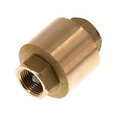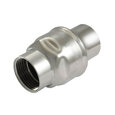Backflow Preventer vs Check Valve
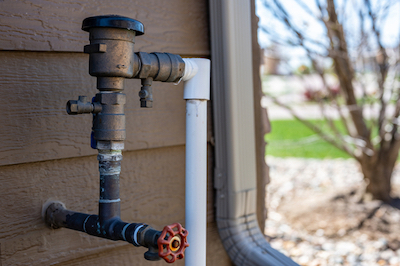
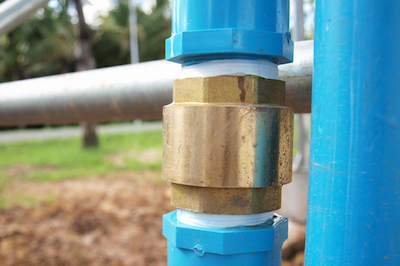
Figure 1: A backflow preventer (up) and check valve (down).
While having similar functions, backflow preventers and check valves are distinctly different devices by application. A backflow preventer is necessary to prevent contaminated water from flowing into potable or municipal water sources. Check valves are also one way valves, but cannot offer the high level of protection that backflow preventers do. This article overviews the primary differences between backflow preventers and check valves and describes different types of backflow preventers.
Table of contents
- What is backflow?
- What is a backflow preventer?
- What is a check valve?
- Backflow preventer vs check valve
- Types of backflow preventers
- FAQs
View our online selection of check valves!
What is backflow?
Backflow is the reversal of a fluid's flow due to back pressure or back siphoning. If backflow occurs, it can cause issues for certain applications. For example, if contaminated water backflows into a clean water supply.
- Back pressure: The demand side pressure exceeds the supply side pressure, causing the media to move towards the supply side.
- Back siphoning: The supply-side water pressure significantly decreases, causing contaminated water to be drawn into the supply. This can happen due to a break in the water main or a discharge from a fire hydrant.
What is a backflow preventer?
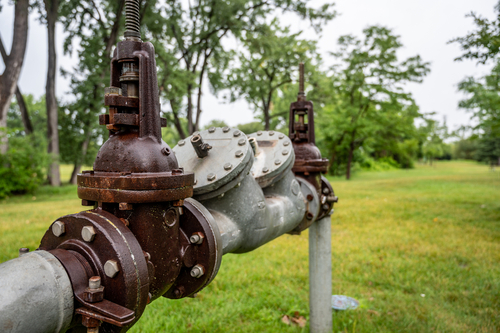
Figure 2: A backflow preventer on a water main pipe.
A backflow preventer’s function (Figure 2) is to stop water from flowing in the opposite direction. The only purpose of a backflow preventer is to stop contaminated water from flowing into a source of potable water. Backflow preventers are installed at cross-connection points, such as where municipal drinking water enters a residential or commercial building or where the water supply attaches to appliances like a washing machine or dishwasher. Check with the local regulations to understand exactly where backflow preventers are necessary in a plumbing system.
High degree of protection
Backflow preventers offer protection through their multiple failsafe features in case of backflow. One example is the double check valve assembly (DCVA) which has two check valves and an atmospheric vent for protection, with a backup valve in case of failure. The vent creates an air gap to prevent backflow from backpressure. If the vent becomes blocked, a relief valve opens to release pressure and prevent contaminated water from flowing back into the main supply. The DCVA's combination of check valves, vent, and relief valve provides a failsafe design to protect the main water supply. Other types of backflow preventers similarly offer multiple failsafe features.
What is a check valve?
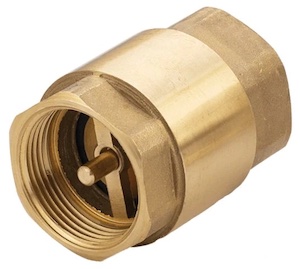
Figure 3: A brass check valve
Like a backflow preventer, a check valve stops media from flowing through it in the reverse direction. Check valves, however, do not offer the degree of protection that backflow preventers do and therefore are not suitable for protecting drinking water sources. If foreign material enters the check valve, it may block it open. In this case, there is no failsafe; the check valve will leak. Also, when check valves close too quickly, they become vulnerable to water hammer, which will damage the valve. Despite this, check valves are applicable for many applications. To learn about these valves in general, read our check valve overview article.
Backflow preventer vs check valve
The following table outlines the most important differences between check valves and backflow preventers.
| Backflow preventer | Check valve | |
| Main Function | Stops contaminated water from flowing into potable water sources | Stops fluid from flowing through it in the opposite direction |
| Applications | Protects drinking water sources | Aquariums, sewer systems, plumbing systems, air lines, sump pumps, and more |
| Protection | Multiple layers of protection. For example, two check valves | One layer of protection: the valve’s disc on the seat |
| Installation location | At the outlet of wherever drinking water flows into systems that can contaminate it (e.g., appliances, from city water to residential plumbing system) | Wherever backflow can damage part of the system. For example, a check valve stops water from flowing out of a well pump, which keeps it primed. |
| Cost | 2 - 3x more expensive than check valves | Less expensive |
Types of backflow preventers
There are different types of backflow preventers with varying mechanisms. The best backflow preventer for an application may depend on local regulations or specifics of the plumbing system.
- Air gap: An air gap is a large non-mechanical backflow preventer that requires a relatively large amount of space but prevents contaminated water from entering the public water supply by having the discharge pipe sit at least two times its diameter above the receiving vessel.
- A double-check valve assembly (DCVA): A double-check valve assembly (DCVA) is a backflow preventer suitable for low to medium-hazard applications such as irrigation or fire sprinkler systems. It consists of two independent check valves that work together to prevent backflow.
- Hose bib vacuum breaker: A hose bib vacuum breaker is for outdoor faucets that connect to a hose. It uses a single spring-loaded inline valve to prevent back siphoning from a non-potable water source (e.g., a bucket, pool, or puddle) through the hose's end by closing and opening depending on the water pressure.
- Reduced pressure zone device (RPZD): RPZDs are applicable for high-risk applications. An RPZD has two independent spring-loaded check valves, a pressure-monitored chamber called the zone and a differential pressure relief valve. It is suitable for safeguarding drinking water and deterring health hazards.
- Atmospheric vacuum breaker (AVB): An AVB is a brass backflow preventer that uses normal water pressure to hold up a poppet valve, preventing back-siphonage by allowing air in when pressure falls; it is mainly used in irrigation systems with non-potable water supply downstream from the protected potable water source.
- Pressure vacuum breaker (PVB): A PVB is a type of backflow preventer with a spring-loaded poppet valve, allowing it to be used in systems where the non-potable water supply is upstream, and it has test cocks with calibrated gauges for proper functioning, commonly used in underground sprinkler systems.
FAQs
Is a check valve a backflow preventer?
Check valves and backflow preventers are two different devices. Backflow preventers are specifically designed to prevent contaminated water from mixing with potable or municipal water sources.
Is a check valve a safe substitute for a backflow preventer?
A check valve cannot be regarded as a safe substitute for a backflow preventer, especially when safeguarding drinking water.
What is the difference between a backwater valve vs check valve?
A backwater valve is used to prevent sewage from flowing back into a building. A check valve stops media from flowing through it in the reverse direction. These two valves differ in their application.
What is the difference between a backwater valve vs backflow preventer?
A backwater valve stops sewage from flowing back into a building whereas a backflow preventer valve prevents contaminated water from mixing with drinking water.




